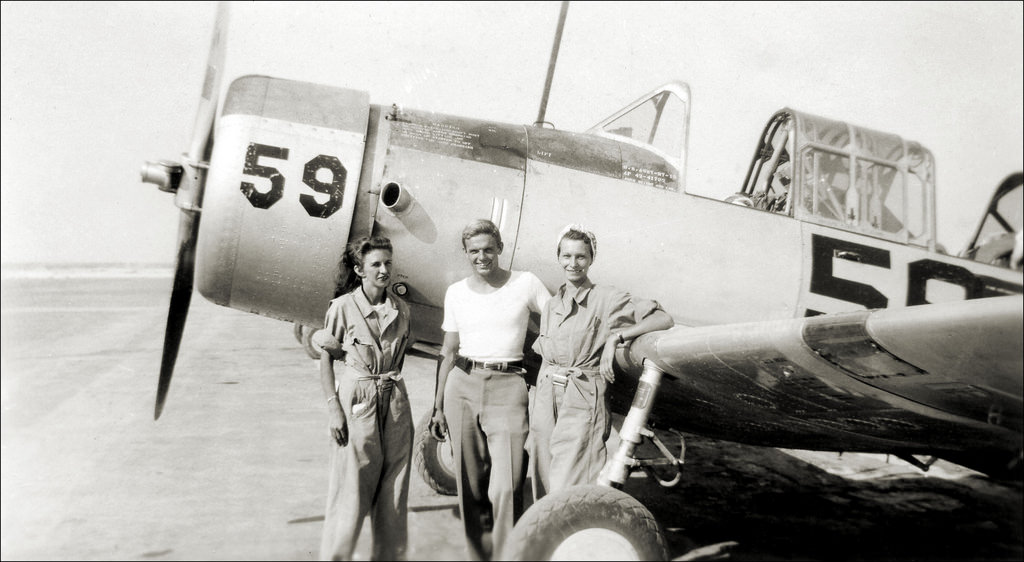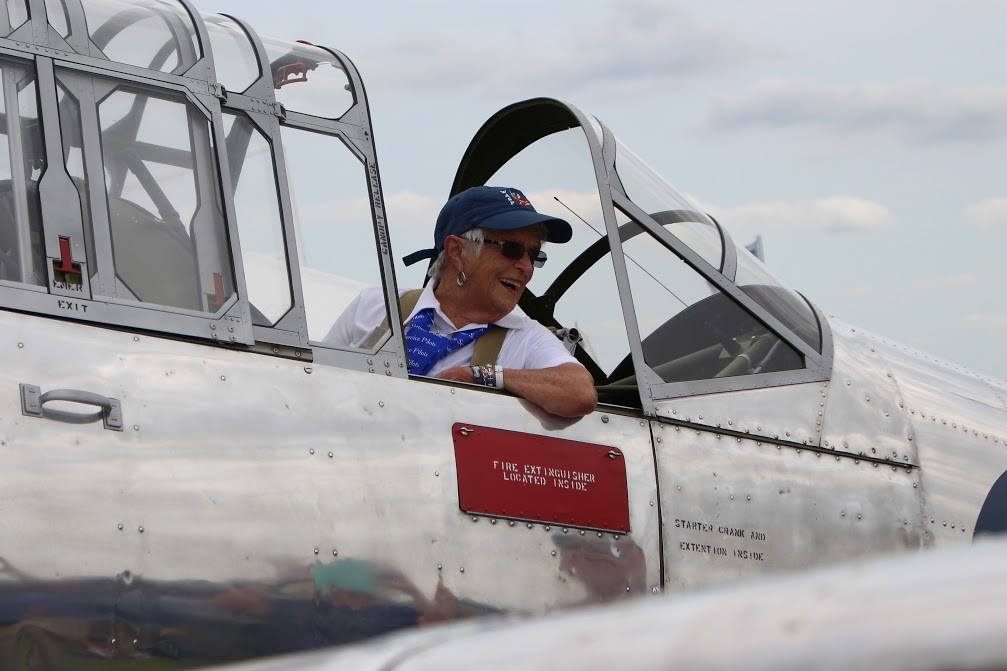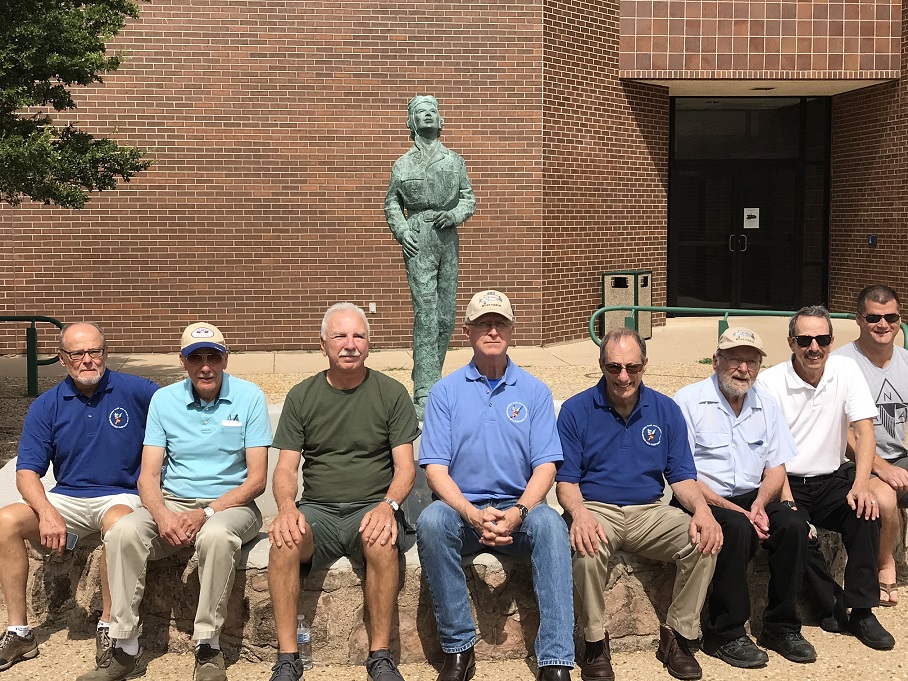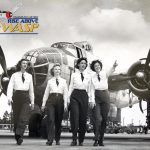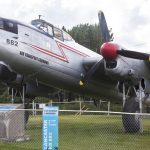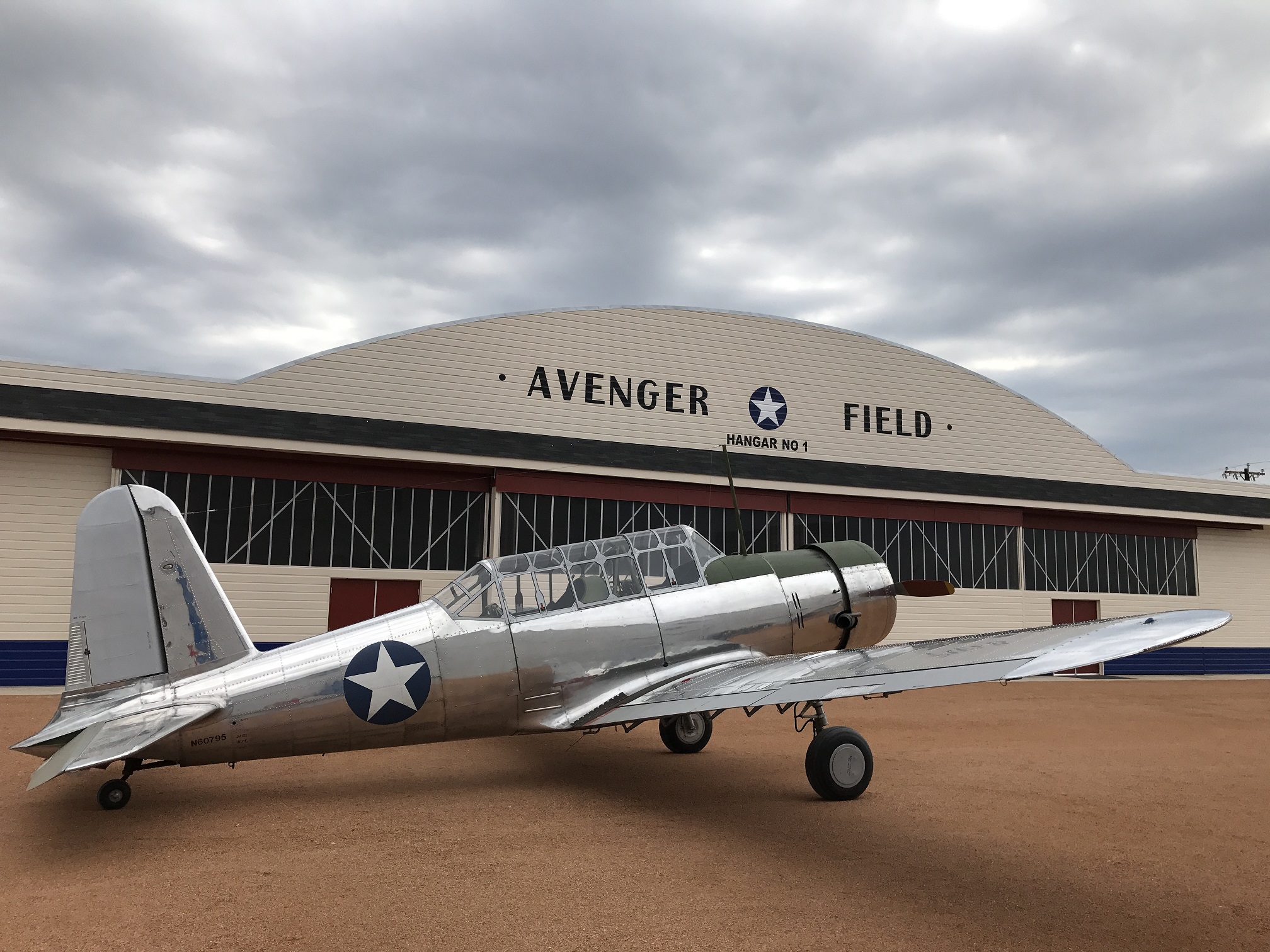
The National WASP WWII Museum celebrated The Gift of Wings on Saturday, September 16, 2017, with a fly-in of a restored BT-13 aircraft donated by the American Aviation Heritage Foundation (AAHF) of Blaine, Minnesota. Ann Hobing, Executive Director of the National WASP WWII Museum, welcomed the crowd in the outdoor plaza to view the Museum’s new BT-13 after watching it fly over Avenger Field. “Today we are immensely grateful to the American Aviation Heritage Foundation for their generosity of time, talent and energy to restore this beautiful warbird and for gifting it in honor of the Women Airforce Service Pilots,” Hobing said.
From September 1939 to the Summer of 1944, BT-13s were built to meet the needs of the U.S. Army Air Corps, later, the U.S. Army Air Forces, and the U.S. Navy, making the plane one of the most important American trainer aircraft of World War II. The BT-13 production run outnumbered all other Basic Trainer (BT) types produced. The Valiant was also known as the “Vultee Vibrator”, nicknamed by its pilots. Fewer than 50 of these aircraft are airworthy today and it remains a beloved aircraft of Women Airforce Service Pilots.
The pilots of the American Aviation Heritage Foundation, Ingemar Holm and Jordan Deters, flew the BT-13 from their hangar in Blaine, Minnesota to Avenger Field, an 1100 mile journey in the vintage warbird. A two day trip, the pilots stopped over near Wichita, Kansas where they were welcomed by a member o the Museum for a meal and tank of gas. The President and CEO of the AAHF, Terry Baker, traveled with five of the restoration crew. Baker said, “This is a five year labor of love for the men who gave their blood, sweat and tears to this project. It took approximately 20,000 hours of work to transform this old warbird to make her airworthy, and we wanted her to come home to the place the WASP trained and sacrificed for our nation.”
The AAHF was inspired by WASP Elizabeth (Betty) Wall Strohfus, from Faribault, Minnesota, who saw this aircraft during its restoration before her death in March 2016. WASP flew every type of plane in the Army Air Corps during World War II and frequently met adversity for being women. Betty simply wanted to fly and to serve her country. She famously said, “The planes….never asked if you were a man or a woman.”
After the ceremonial presentation of the BT-13 to the National WASP WWII Museum, the restoration crew of the American Aviation Heritage Foundation delivered an educational program about the project, explaining how to transform a 2 ½ ton machine to flight status. Jordan Deters, one of the pilots who flew the plane to Sweetwater, said, “To fly a warbird is different than modern aircraft. There is a lot of trust that goes into a project like this when you are flying something 75 years old. This team has done amazing work and I am honored to be a part of it all.”
The highlight of the restoration team’s day was meeting Jessie Lou McReynolds, a 96 year old Sweetwater native who was one of only three female mechanics at Avenger Field during WWII. McReynolds talked with the men about her work at the base, which consisted of routine tasks like changing spark plugs and more advanced duties. She said, “I always took my job seriously because I knew the lives of the pilots relied on the quality of my work.” When McReynolds saw the BT-13 parked in the Museum’s outdoor plaza, she smiled and said, “Yes, that looks about right.”
Before their departure from Sweetwater, the AAHF crew stopped for an emotional pilgrimage to the Wishing Well, adjacent to Avenger Field, where the WASP return annually for their Homecoming photograph every Memorial Day weekend. Terry Baker said, “This is why we did this project; to honor those brave women who served our country. The BT-13 is a representation of their work, but The Gift of Wings is about the human element; it’s about the WASP, each of whom has a story to be preserved and shared.” President of the Board of Directors of the National WASP WWII Museum, Sandra Spears, reassured the AAHF crew, “Thank you for your generosity; and we promise, we will take care of your baby.”
As part of Phase 2 of the Museum’s expansion project, the Museum will continue to raise funds and accept donations to undergo an exhibit master design plan to create an engaging guest experience across the Museum’s complex. Phase 1, completed this summer, was the construction of Hangar No 1
modeled after the hangar at Avenger Field where the WASP trained. “Our mission is to educate and preserve, and acquisition of this BT-13 as part of our collection makes it our duty to complete the next phase of our Museum’s growth with integrity and dedication to the military heritage at Avenger Field,” Hobing said.
About National WASP WWII Museum
Adjacent to a Texas Historical Commission Landmark and a destination on Texas Forts Trail, National WASP WWII Museum at Avenger Field was incorporated by the State of Texas in 2003 and held its grand opening in 2005. A 501(c)(3) nonprofit relying on contributions and dedicated to honoring the legacy of Woman Airforce Service Pilots and inspiring future generations, National WASP WWII Museum hosts an annual Homecoming, welcoming WASP and their families to remember those with whom they served.Home to archives, exhibits and aircraft preserving the story of WASP and those who served at Avenger Field, National WASP WWII Museum tells the story of WASP during WWII and the years after their service in which they continued to seek the veteran status and full military honors due them. For more information, visit www.waspmuseum.org or Facebook @waspmuseum.
About American Aviation Heritage Foundation
The American Aviation Heritage Foundation, established in Blaine, Minnesota in 1994, engages in aviation education to foster an awareness of and promote interest in, the aviation heritage of the United States of America. The Foundation operates exclusively for educational and charitable purposes within the meaning of Section 501(c)(3) of the Internal Revenue Code in recognition of the tremendous impact on and benefit to the lives of individual Americans, and in recognition of the need to preserve, for the benefit of future generations of Americans, the heritage of aviation that is uniquely American, and to encourage and inspire Americans to actively participate in aviation-related activities which may benefit themselves, their community and the nation.For more information, visit Facebook @AmericanAviationHeritageFoundation.








